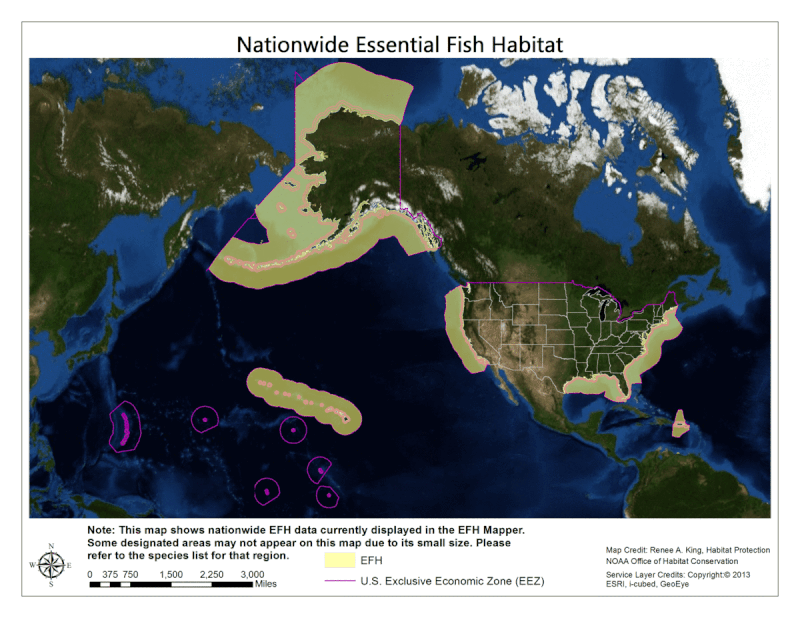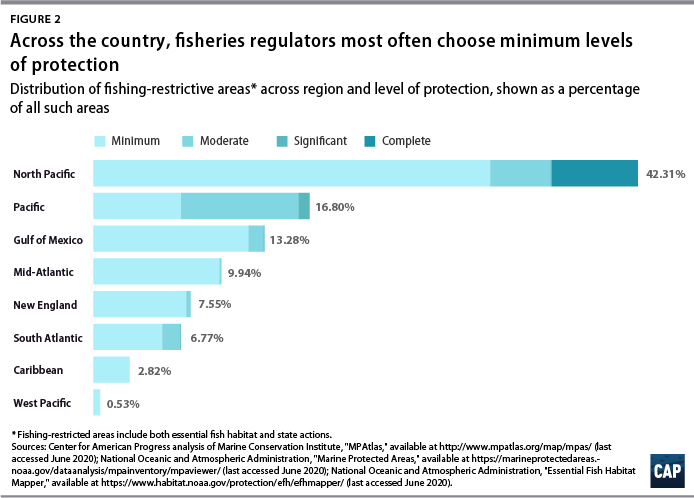How
the US Fails Its Most Important Fish Habitats
 |
| Photo by Will Collette |
This argument is simple, eye-catching and undeniably true from a
scientific perspective: if we want healthy populations of fish, crabs and
shrimp, we need to protect key habitat where they live, breed and feed.
But do we?
The answer to that question, according to new report from the Center for American Progress, is a
resounding no.
Not only that, things have gotten worse for fish habitats — and
consequently, fisheries — since the Trump administration took office. And that
puts fish populations, ecosystems, and part of the human food system at risk.
The heart of the problem, according to the report, lies the way
we manage what’s known under U.S. law as an EFH, or “essential fish habitat.” These EFHs represent 800 million
acres of habitat, including breeding and feeding sites for nearly 1,000
federally managed species, covering everything from coral reefs to rivers and
wetlands.
Under the EFH regulatory structure, the National Oceanic and
Atmospheric Administration works with U.S. fisheries
management councils — groups that consist of government managers and
representatives from industry, academia and the environmental community — to
identify and map these habitats.
The law also gives fisheries councils virtually all the power
and responsibility to protect these critical habitats and the sensitive species
that live in them from manmade threats, including destructive fishing gear.
Unfortunately, according to the new report, councils are
largely not using their power to protect. Despite their
designation as “essential,” most of these habitats have no additional
protections at all — they’re not managed differently than any other kind of
marine or river habitats. Much of the rest isn’t protected strongly enough,
according to the Center’s examination.


Map of essential fish habitats overlaid with those that have
protections in place. Source: NOAA
Ocean policy analyst Alexandra Carter, the report’s lead author, tells me they set out to understand the scope of the problem, but did not expect what they found.
“We were floored at how much identified EFH there is, but how
little actual protections result from it,” she says.
In fact, the report concludes with an alarming warning, “The
vast majority of U.S. waters have insufficient protections for ensuring a
healthy future for American fisheries and oceans.”
The Weakest Link
Of the few areas that had protections, three-quarters had what
the authors call “minimal protections” — usually just minor modifications to
fishing gear that don’t accomplish much conclusive good.
One example of such a minor gear modification can be found in the Gulf of Mexico, where bottom-trawl nets dragged across the seafloor feature a heavy chain called a “tickler,” which improves catches by stirring up bottom-dwelling species like crabs, but which can also do a lot of damage to the habitat.
In order to minimize the risk of damage, the EFH protection established by the Gulf of Mexico Fishery Management Council requires the tickler chain to have one link weaker than all the others. This supposedly enables the chain to break, if necessary, rather than continue to damage habitat.
This sounds good in principle, but according to Carter, “There’s
no rule about how weak the link is supposed to be. It just has
to be weaker than the other links.”
In many cases, the requirements to protect identified these key
habitats consist entirely of things that fishermen were already doing, such as
gear modifications put in place because they improve fishing, not because they
protect the habitat
“That means there’s little additional protection, if any at
all,” Carter says. “A list of new rules that consists of things people were
already doing is not really what we think of when we think of a new protected
area.”
How can this be? Well, according to Gib Brogan, an Oceana senior
campaign manager who wasn’t involved in this report, the process of identifying
what counts as EFH is a scientific one with clear guidelines, but what’s
supposed to be done to protect an EFH once it’s identified is a lot more
flexible.
“There’s been a lot of latitude given to the fisheries
management councils,” he says. “Fishery managers have to make rules to minimize
the adverse effects of fishing, but there’s lots of discretion about what
exactly that means. And it’d be tough to make the case that the councils are
fully implementing and fully achieving the requirements of the law. Habitat
protection is often treated as a nuisance by managers, addressed not because
it’s a priority but because the courts say they have to after they’re sued.”
A Worsening Problem
While this is a longstanding problem, it, like many other
environmental issues, has gotten worse during the Trump administration.
“Science-based management is the key to modern fisheries, and
the current administration doesn’t value science particularly highly,” Brogan
says.
The regulations and processes for identifying EFH haven’t
changed, but Carter notes that there’s been a noticeable change in attitude
among the councils as a result of the Trump administration’s anti-regulation
agenda.
It was pressure from the New England fisheries management council, for example, that resulted in recent news that an Atlantic marine protected area would lose its protections. And a recent Executive Order solicited recommendations from councils for ways the administration could reduce regulatory burdens on fisheries.
It was pressure from the New England fisheries management council, for example, that resulted in recent news that an Atlantic marine protected area would lose its protections. And a recent Executive Order solicited recommendations from councils for ways the administration could reduce regulatory burdens on fisheries.

Source: Center for American Progress
There have also been other, non-EFH related cases where the administration ignored science when getting involved in fisheries management, including issues related to recreational fisheries management and issues related to marine zoning.
“If we just let the councils ask the president to allow fishing
in all our MPAs and not have any protections in essential fish habitats, we’re
just not doing the best we can for our ocean ecosystems,” Carter says. “The
councils are poised to take advantage of any opportunities to allow more
fishing. It’s my opinion that with the Trump administration these opportunities
seem to be much more abundant than in previous administrations.”
Of course, most of the protected EFH areas aren’t what
scientists typically talk about when discussing marine protected areas,
especially in the context of a goal to strongly protect 30% of the ocean by
2030. But experts say establishing stronger protections in EFHs would
contribute to the same goals.
The report also cites the administration’s trade policies and the continuing threat of climate change as elements that have worsened EFH protection over the past three and a half years.
Can We Solve This Problem?
The report includes two key suggestions for improving the way we
use EFH regulations to protect the oceans.
The biggest is to introduce a new requirement that any
identified essential fish habitat have at least some substantive protections,
usually in the form of restricting what kind of destructive fishing practices
can or can’t take place there. Just noting that a place is important and should
be protected without giving it any kind of actual protection, the authors say,
is not especially useful.
And while there’s value in allowing the councils broad latitude to make solutions that work for local conditions, the fact that so much EFH remains unprotected or minimally protected is cause for concern and a reason for reform.
And while there’s value in allowing the councils broad latitude to make solutions that work for local conditions, the fact that so much EFH remains unprotected or minimally protected is cause for concern and a reason for reform.
The report also suggests ways to improve the public consultation
process for designating and protecting essential fisheries habitats. This is
often used for other environmental regulations under U.S. law and has allowed
for a more transparent and effective process.
“We should have EFH, but we should improve it so it’s
meaningful,” Carter says. “If we’re not doing what we can to preserve the
valuable resources we have in the ocean, we are failing the future fishing
industry of America. Protecting the ocean is a promise to the future to maintain
public resources for the benefit of everyone.”
David
Shiffman is a marine biologist specializing in the ecology and conservation
of sharks. He received his Ph.D. in environmental science and policy from the
University of Miami. Follow him on Twitter, where he's always happy to answer
any questions anyone has about sharks. http://twitter.com/whysharksmatter